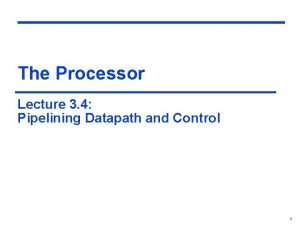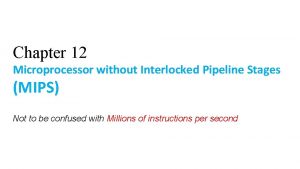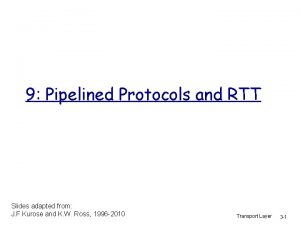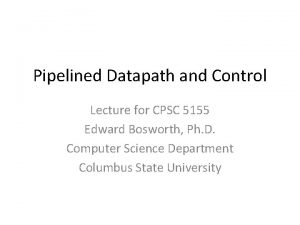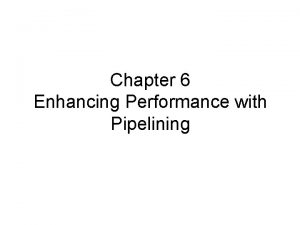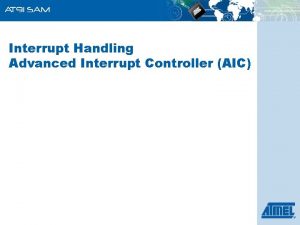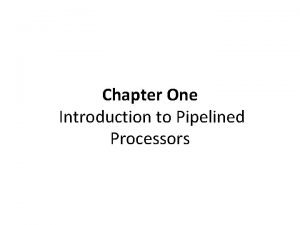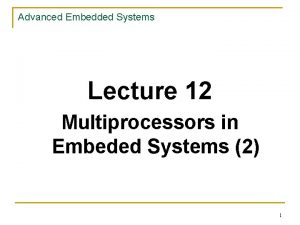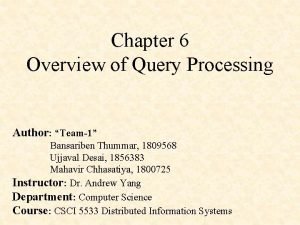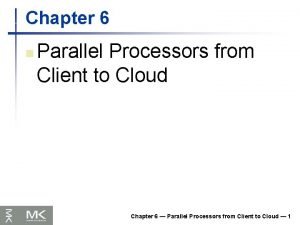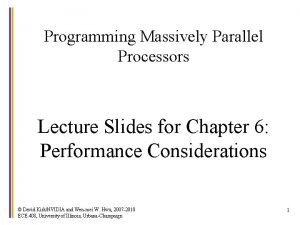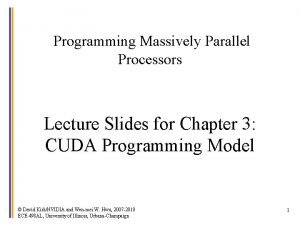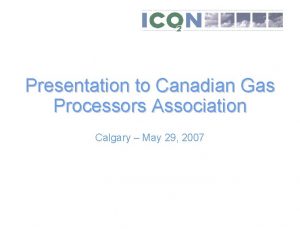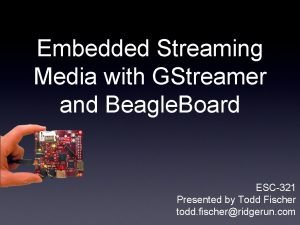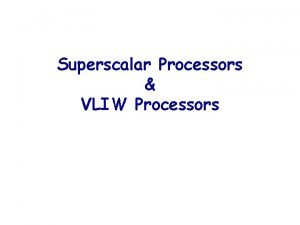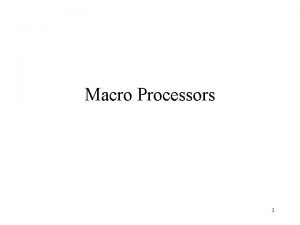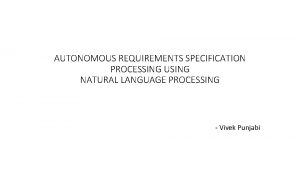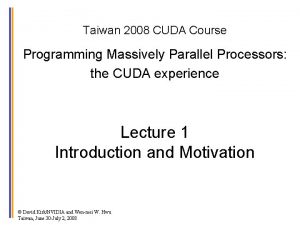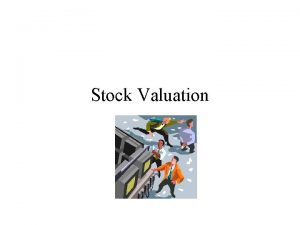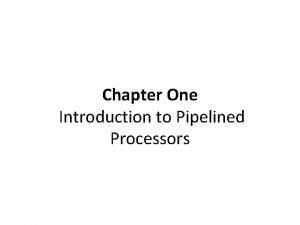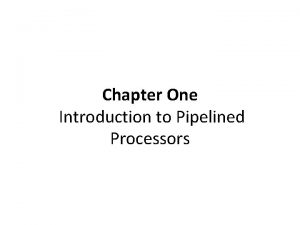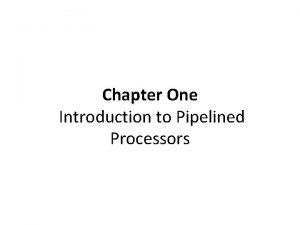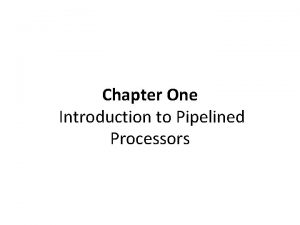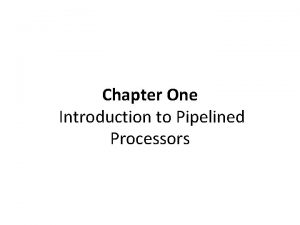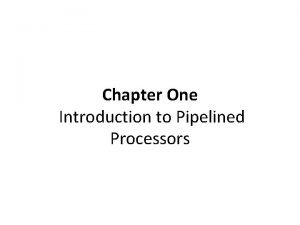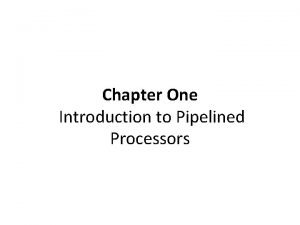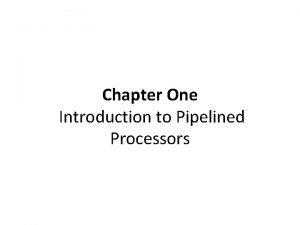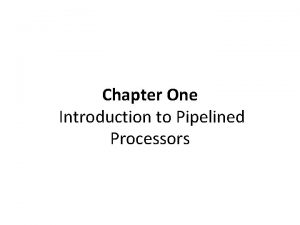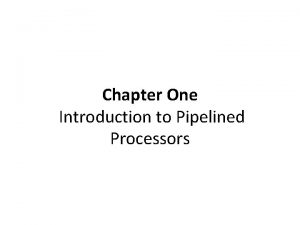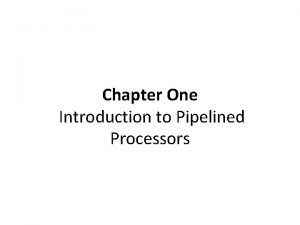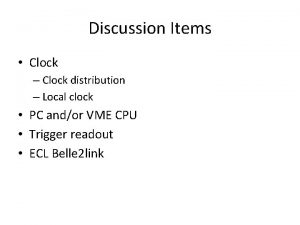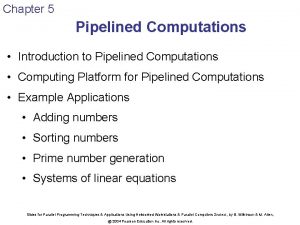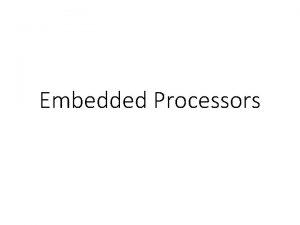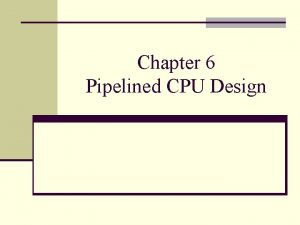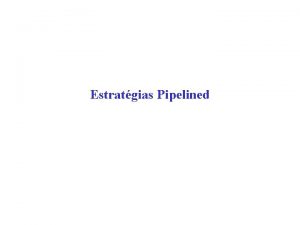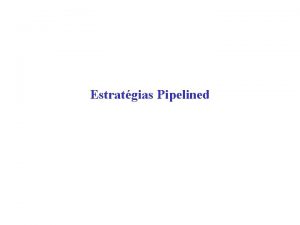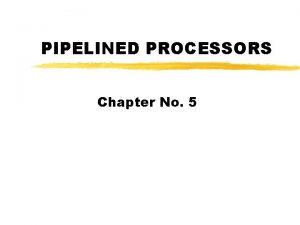Chapter One Introduction to Pipelined Processors Clock Period







![Speed-up • The maximum value of speedup is Lt [Speedup] = k n ∞ Speed-up • The maximum value of speedup is Lt [Speedup] = k n ∞](https://slidetodoc.com/presentation_image_h2/22b2aff0ed9d7f38f5596e62f42fd55a/image-8.jpg)





![Throughput • The maximum value of throughput is Lt [Throughput] = ? n ∞ Throughput • The maximum value of throughput is Lt [Throughput] = ? n ∞](https://slidetodoc.com/presentation_image_h2/22b2aff0ed9d7f38f5596e62f42fd55a/image-14.jpg)
![Throughput • The maximum value of throughput is Lt [Throughput] = f n ∞ Throughput • The maximum value of throughput is Lt [Throughput] = f n ∞](https://slidetodoc.com/presentation_image_h2/22b2aff0ed9d7f38f5596e62f42fd55a/image-15.jpg)











































- Slides: 58

Chapter One Introduction to Pipelined Processors

Clock Period (τ) for the pipeline • Let τi be the time delay of the circuitry Si and t 1 be time delay of latch. • Then the clock period of a linear pipeline is defined by • The reciprocal of clock period is called clock frequency (f = 1/τ) of a pipeline processor.

Performance of a linear pipeline • Consider a linear pipeline with k stages. • Let T be the clock period and the pipeline is initially empty. • Starting at any time, let us feed n inputs and wait till the results come out of the pipeline. • First input takes k periods and the remaining (n-1) inputs come one after the another in successive clock periods. • Thus the computation time for the pipeline Tp is Tp = k. T+(n-1)T = [k+(n-1)]T

Performance of a linear pipeline • For example if the linear pipeline have four stages with five inputs. • Tp = [k+(n-1)]T = [4+4]T = 8 T

Performance Parameters The various performance parameters of pipeline are : 1. Speed-up 2. Throughput 3. Efficiency •

Speedup • Speedup is defined as Speedup = Time taken for a given computation by a non-pipelined functional unit Time taken for the same computation by a pipelined version • Assume a function of k stages of equal complexity which takes the same amount of time T. • Non-pipelined function will take k. T time for one input. • Then Speedup = nk. T/(k+n-1)T = nk/(k+n-1)

Speed-up • For e. g. , if a pipeline has 4 stages and 5 inputs, its speedup factor is Speedup = ? • The maximum value of speedup is Lt [Speedup] = ? n ∞
![Speedup The maximum value of speedup is Lt Speedup k n Speed-up • The maximum value of speedup is Lt [Speedup] = k n ∞](https://slidetodoc.com/presentation_image_h2/22b2aff0ed9d7f38f5596e62f42fd55a/image-8.jpg)
Speed-up • The maximum value of speedup is Lt [Speedup] = k n ∞

Efficiency • It is an indicator of how efficiently the resources of the pipeline are used. • If a stage is available during a clock period, then its availability becomes the unit of resource. • Efficiency can be defined as

Efficiency • No. of used stage time units = nk – there are n inputs and each input uses k stages. • Total no. of stage-time units available = k[ k + (n-1)] – It is the product of no. of stages in the pipeline (k) and no. of clock periods taken for computation(k+(n-1)).

Efficiency • Thus efficiency is expressed as follows: • The maximum value of efficiency is

Efficiency • Efficiency is minimum when n = 1. • Minimum value of Efficiency = ? • For k = 4 and n = 5, Efficiency = ?

Throughput • It is the average number of results computed per unit time. • For n inputs, a k-staged pipeline takes [k+(n -1)]T time units • Then, Throughput = n / [k+n-1] T = nf / [k+n-1] where f is the clock frequency
![Throughput The maximum value of throughput is Lt Throughput n Throughput • The maximum value of throughput is Lt [Throughput] = ? n ∞](https://slidetodoc.com/presentation_image_h2/22b2aff0ed9d7f38f5596e62f42fd55a/image-14.jpg)
Throughput • The maximum value of throughput is Lt [Throughput] = ? n ∞
![Throughput The maximum value of throughput is Lt Throughput f n Throughput • The maximum value of throughput is Lt [Throughput] = f n ∞](https://slidetodoc.com/presentation_image_h2/22b2aff0ed9d7f38f5596e62f42fd55a/image-15.jpg)
Throughput • The maximum value of throughput is Lt [Throughput] = f n ∞ • Throughput = Efficiency x Frequency

Example : Floating Point Adder Unit

Floating Point Adder Unit • This pipeline is linearly constructed with 4 functional stages. • The inputs to this pipeline are two normalized floating point numbers of the form A = a x 10 p B = b x 10 q where a and b are two fractions and p and q are their exponents.

Floating Point Adder Unit • Our purpose is to compute the sum C = A + B = c x 10 r = d x 10 s where r = max(p, q) and 0. 1 ≤ d < 1 • For example: A=0. 9504 x 103 B=0. 8200 x 102 a = 0. 9504 b= 0. 8200 p=3 & q =2

Floating Point Adder Unit Operations performed in the four pipeline stages are : 1. Compare p and q and choose the largest exponent, r = max(p, q)and compute t = |p – q| Example: r = max(p , q) = 3 t = |p-q| = |3 -2|= 1 •

Floating Point Adder Unit 2. Shift right the fraction associated with the smaller exponent by t units to equalize the two exponents before fraction addition. • Example: Smaller exponent, b= 0. 8200 Shift right b by 1 unit is 0. 082

Floating Point Adder Unit 3. Perform fixed-point addition of two fractions to produce the intermediate sum fraction c • Example : a = 0. 9504 b= 0. 082 c = a + b = 0. 9504 + 0. 082 = 1. 0324

Floating Point Adder Unit 4. Count the number of leading zeros (u) in fraction c and shift left c by u units to produce the normalized fraction sum d = c x 10 u, with a leading bit 1. Update the large exponent s by subtracting s = r – u to produce the output exponent. • Example: c = 1. 0324 , u = -1 right shift d = 0. 10324 , s= r – u = 3 -(-1) = 4 C = 0. 10324 x 104

Floating Point Adder Unit • The above 4 steps can all be implemented with combinational logic circuits and the 4 stages are: 1. Comparator / Subtractor 2. Shifter 3. Fixed Point Adder 4. Normalizer (leading zero counter and shifter)

4 -STAGE FLOATING POINT ADDER A = a x 2 p a b Stages: S 1 B = b x 2 q A Other fraction Exponent subtractor Fraction selector Fraction with min(p, q) r = max(p, q) t = |p - q| Right shifter Fraction adder c S 2 r Leading zero counter S 3 c Left shifter r d S 4 B Exponent adder s C= X + Y = d x 2 s d

Example for floating-point adder Exponents a Mantissas b R Segment 1: A Difference=3 -2=1 For example: X=0. 9504*103 Y=0. 8200*102 Align mantissas Choose exponent 3 R Adjust exponent R 0. 082 R Add mantissas Segment 3: Segment 4: R Compare exponents by subtraction R Segment 2: B S=0. 9504+0. 082=1. 0324 R 4 Normalize result R 0. 10324

Classification of Pipeline Processors • There are various classification schemes for classifying pipeline processors. • Two important schemes are 1. Handler’s Classification 2. Li and Ramamurthy's Classification

Handler’s Classification • Based on the level of processing, the pipelined processors can be classified as: 1. Arithmetic Pipelining 2. Instruction Pipelining 3. Processor Pipelining

Arithmetic Pipelining • The arithmetic logic units of a computer can be segmented for pipelined operations in various data formats. • Example : Star 100

Arithmetic Pipelining

Arithmetic Pipelining • Example : Star 100 – It has two pipelines where arithmetic operations are performed – First: Floating Point Adder and Multiplier – Second : Multifunctional : For all scalar instructions with floating point adder, multiplier and divider. – Both pipelines are 64 -bit and can be split into four 32 -bit at the cost of precision

Star 100 Architecture

Instruction Pipelining • The execution of a stream of instructions can be pipelined by overlapping the execution of current instruction with the fetch, decode and operand fetch of the subsequent instructions • It is also called instruction look-ahead

Instruction Pipelining

Example : 8086 • The organization of 8086 into a separate BIU and EU allows the fetch and execute cycle to overlap.

Processor Pipelining • This refers to the processing of same data stream by a cascade of processors each of which processes a specific task • The data stream passes the first processor with results stored in a memory block which is also accessible by the second processor • The second processor then passes the refined results to the third and so on.

Processor Pipelining

Li and Ramamurthy's Classification • According to pipeline configurations and control strategies, Li and Ramamurthy classify pipelines under three schemes – Unifunction v/s Multi-function Pipelines – Static v/s Dynamic Pipelines – Scalar v/s Vector Pipelines

Uni-function v/s Multi-function Pipelines

Unifunctional Pipelines • A pipeline unit with fixed and dedicated function is called unifunctional. • Example: CRAY 1 (Supercomputer - 1976) • It has 12 unifunctional pipelines described in four groups: – Address Functional Units: • Address Add Unit • Address Multiply Unit

Unifunctional Pipelines – Scalar Functional Units • • Scalar Add Unit Scalar Shift Unit Scalar Logical Unit Population/Leading Zero Count Unit – Vector Functional Units • Vector Add Unit • Vector Shift Unit • Vector Logical Unit

Unifunctional Pipelines – Floating Point Functional Units • Floating Point Add Unit • Floating Point Multiply Unit • Reciprocal Approximation Unit

Cray 1 : Architecture


Cray -1

Multifunctional • A multifunction pipe may perform different functions either at different times or same time, by interconnecting different subset of stages in pipeline. • Example 4 X-TI-ASC (Supercomputer - 1973)

4 X-TI ASC • It has four multifunction pipeline processors, each of which is reconfigurable for a variety of arithmetic or logic operations at different times. • It is a four central processor comprised of nine units.

Multifunctional • It has – one instruction processing unit – four memory buffer units and – four arithmetic units. • Thus it provides four parallel execution pipelines below the IPU. • Any mixture of scalar and vector instructions can be executed simultaneously in four pipes.

Architecture Overview of 4 X-TI ASC

Static Vs Dynamic Pipeline

Static Pipeline • It may assume only one functional configuration at a time • It can be either unifunctional or multifunctional • Static pipelines are preferred when instructions of same type are to be executed continuously • A unifunction pipe must be static.

Dynamic pipeline • It permits several functional configurations to exist simultaneously • A dynamic pipeline must be multi-functional • The dynamic configuration requires more elaborate control and sequencing mechanisms than static pipelining

Scalar Vs Vector Pipeline

Scalar Pipeline • It processes a sequence of scalar operands under the control of a DO loop • Instructions in a small DO loop are often prefetched into the instruction buffer. • The required scalar operands are moved into a data cache to continuously supply the pipeline with operands • Example: IBM System/360 Model 91

IBM System/360 Model 91 • In this computer, buffering plays a major role. • Instruction fetch buffering: – provide the capacity to hold program loops of meaningful size. – Upon encountering a loop which fits, the buffer locks onto the loop and subsequent branching requires less time. • Operand fetch buffering: – provide a queue into which storage can dump operands and execution units can fetch operands. – This improves operand fetching for storage-toregister and storage-to-storage instruction types.

Architecture overview of IBM 360/Model 91


Vector Pipelines • They are specially designed to handle vector instructions over vector operands. • Computers having vector instructions are called vector processors. • The design of a vector pipeline is expanded from that of a scalar pipeline. • The handling of vector operands in vector pipelines is under firmware and hardware control. • Example : Cray 1

 Fast clock to slow clock synchronization
Fast clock to slow clock synchronization 1 minute is 60 seconds
1 minute is 60 seconds Pipelined datapath
Pipelined datapath Pipelined processor design
Pipelined processor design Interlocked pipeline
Interlocked pipeline Pipelining protocol
Pipelining protocol Pipelined datapath
Pipelined datapath Pipelined datapath
Pipelined datapath Programming massively parallel processors
Programming massively parallel processors Linear pipeline
Linear pipeline Aicarm
Aicarm History of processors
History of processors Handlers classification
Handlers classification Digital camera processors
Digital camera processors Advantages and disadvantages of intel processors
Advantages and disadvantages of intel processors Embeded processors
Embeded processors Microcontrollers and embedded processors
Microcontrollers and embedded processors Comparison of word processors
Comparison of word processors Distributed query processing
Distributed query processing Parallel processors from client to cloud
Parallel processors from client to cloud Programming massively parallel processors
Programming massively parallel processors David kirk nvidia
David kirk nvidia Gas processors association
Gas processors association Gstreamer architecture
Gstreamer architecture Network systems design using network processors
Network systems design using network processors Macro processors
Macro processors Vliw processors rely on
Vliw processors rely on Macro instruction arguments
Macro instruction arguments Language and processors for requirement
Language and processors for requirement Networks and telecommunications presentation
Networks and telecommunications presentation Programming massively parallel processors, kirk et al.
Programming massively parallel processors, kirk et al. One god one empire one religion
One god one empire one religion One one little dog run
One one little dog run One king one law one faith
One king one law one faith Byzantine definition
Byzantine definition One ford
One ford See one do one teach one
See one do one teach one See one, do one, teach one
See one, do one, teach one Willow cabin speech
Willow cabin speech See one do one teach one
See one do one teach one One vision one identity one community
One vision one identity one community Asean one vision one identity one community
Asean one vision one identity one community Cynthia lightfoot
Cynthia lightfoot A&p flix activity: resting membrane potential
A&p flix activity: resting membrane potential Absolute refractory period and relative refractory period
Absolute refractory period and relative refractory period Critical period vs sensitive period
Critical period vs sensitive period Critical period
Critical period Approaches to child development
Approaches to child development Music of classical period 1750 to 1820
Music of classical period 1750 to 1820 12 neutrons metallic 11 electrons
12 neutrons metallic 11 electrons In the period of activism
In the period of activism Stability period vs measurement period
Stability period vs measurement period Trustee period and royal period
Trustee period and royal period Ad vs bce
Ad vs bce It's five to twelve
It's five to twelve Gotra meaning
Gotra meaning Generalized dividend valuation model
Generalized dividend valuation model Chapter 3: the european period 1540-1798
Chapter 3: the european period 1540-1798 Introduction paragraph structure
Introduction paragraph structure


